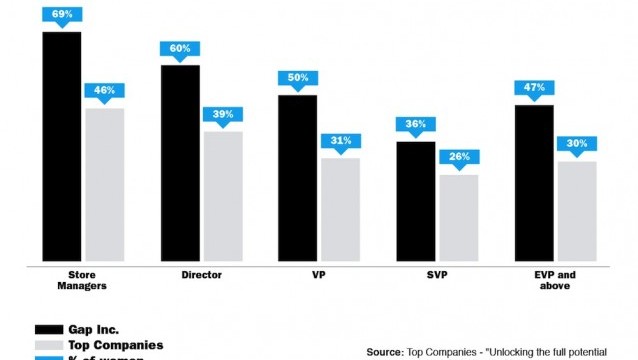Reposted from Think Progress.
American women, on average, make just 77 cents for every dollar a man earns. But that pay gap disappears at clothing chain The Gap.
“[O]n average, women at Gap Inc. are paid at a one-to-one ratio compared to their male counterparts across our organization,” a spokeswoman confirmed for ThinkProgress over email. “Globally, this translates to pay equality across our major geographies, whether dollar for dollar, pound for pound, yen for yen or euro for euro.” While she couldn’t provide an breakdown by position, she noted, “We pay dollar for dollar across the organization, regardless of level.”
The company also fares better than the industry average when it comes to women in leadership, with women making up nearly 70 percent of store managers, 60 percent of directors, 50 percent of vice presidents, and 47 percent of executive vice president level positions and above, as can be seen in a graphic she provided to ThinkProgress:

CREDIT: THE GAP
The spokeswoman added, “We pay people based on the work they do and the value they bring to our company.” The company worked with a firm called Exponential to evaluate its pay by gender and the firm said it hasn’t seen another company in its work over the last 10 years make a statement on equal pay of this nature.
The gender wage gap has made barely any progress in closing in a decade, and while there are many factors that go into it, there is likely outright discrimination at play. Retail is just as guilty as any other industry in this regard. The average woman in retail makes 72 percent of what a man makes, less than the overall average, and salespeople have an even worse gap, making $4 less an hour than men. Women also hold the majority of low-wage retail workers.
The Gap has also made news for a recent change in its payment policies: it announced in February that it would raise the lowest wage it pays its employees to $10 an hour, impacting 65,000 workers. The company said it expects to see “a return many times over” from the policy in its ability to “attract and retain great talent” and improve the customer experience.
It’s also important to note, however, that the company has come under criticism for how it deals with the workers in its supply chain. It has refused to sign on to a legally binding plan to improve conditions in Bangladeshi garment factories after a collapse killed more than 1,000 people last year. Instead, it and other American companies have offered their own watered down version. It was also found to be inadvertently subcontracting child labor in India in 2007.


